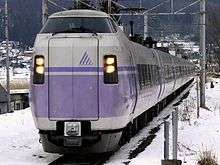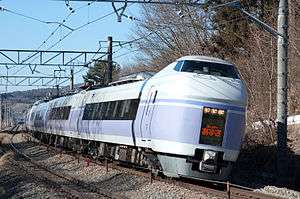E351 series
| E351 series | |
|---|---|
|
E351 series EMU on a Super Azusa service, January 2010 | |
| In service | December 1993–Present |
| Manufacturer | Hitachi and Nippon Sharyo |
| Replaced | 183 series |
| Number built | 60 vehicles (10 sets) |
| Number in service | 60 vehicles (10 sets) |
| Formation | 4/8 cars per trainset |
| Fleet numbers | S1–S5, S21–S25 |
| Operator(s) | JR East |
| Depot(s) | Matsumoto |
| Line(s) served | Chūō Main Line |
| Specifications | |
| Car body construction | Steel |
| Car length | 20,700 mm (67 ft 11 in)–21,680 mm (71 ft 2 in) |
| Width | 2,843 mm (9 ft 3.9 in) |
| Doors | 2 per side |
| Maximum speed | 130 km/h (80 mph) |
| Traction system | MT69 (150 kW) |
| Power output | 3,600 kW per 12-car formation |
| Electric system(s) | 1,500 V DC overhead |
| Current collection method | PS31 single-arm pantograph |
| Bogies | DT62A (motored), TR247 (trailer) |
| Braking system(s) | Regenerative brake, electronically controlled pneumatic brakes, snow-resistant brake |
| Safety system(s) | ATS-P, ATS-Ps |
| Track gauge | 1,067 mm (3 ft 6 in) |
The E351 series (E351系) is a tilting electric multiple unit (EMU) train type operated by East Japan Railway Company (JR East) on Chūō Main Line Super Azusa limited express services in Japan since 1993. First introduced in December 1993 (initially on Azusa services), a total of 60 vehicles were built, formed as five 8-car main sets (numbers S1 to S5) and five 4-car supplementary (numbers S21 to S25) sets.
Concept
Built jointly by Hitachi and Nippon Sharyo,[1] the tilting E351 series trains were intended to replace the ageing 183 series EMUs used on Azusa Limited express services operating between Shinjuku in Tokyo and Matsumoto, and to increase speeds on the highly curved Chūō Main Line.[2]
Operations
- Super Azusa limited express services (since 3 December 1994)
- Chūō Liner rapid services (since 15 March 2008)
Between 16 March 1996 and 14 March 2008, E351 series sets were also used on Tōkaidō Main Line weekday morning Ohayō Liner Shinjuku 22 and evening Home Liner Odawara 27 commuter services.[3]
From spring 2016, the E351 series trains are scheduled to be replaced by new E353 series EMUs on Chuo Line limited express services,[4] and will be relegated to seasonal use.[5]
Formations

The fleet consists of five 4-car sets (S21–S25) and five 8-car sets (S1–S5), formed as shown below, with car 1 (car 5) at the Shinjuku or Tokyo end.[2][3]
4-car sets S21–S22
| Car No. | 1 | 2 | 3 | 4 |
|---|---|---|---|---|
| Designation | Tc' | M1 | M2 | Tc' |
| Numbering | KuHa E351-1100 | MoHa E351-1000 | MoHa E350-1000 | KuHa E351-1200 |
| Seating capacity | 60 | 52 | 68 | 52 |
| Weight (t) | 36.9 | 39.7 | 39.8 | 38.2 |
- Car 4 has a retracting gangway.
- Car 2 is fitted with a PS31 single-arm pantograph.
- Cars 2 and 4 are fitted with toilets.
4-car sets S23–S25
| Car No. | 1 | 2 | 3 | 4 |
|---|---|---|---|---|
| Designation | Tc | M1 | M2 | Tc' |
| Numbering | KuHa E351 | MoHa E351 | MoHa E350 | KuHa E350-100 |
| Seating capacity | 60 | 52 | 68 | 52 |
| Weight (t) | 38.3 | 38.3 | 37.9 | 36.3 |
- Car 4 has a retracting gangway.
- Car 2 is fitted with a PS31 single-arm pantograph.
- Cars 2 and 4 are fitted with toilets.
8-car sets S1–S2
| Car No. | 5 | 6 | 7 | 8 | 9 | 10 | 11 | 12 |
|---|---|---|---|---|---|---|---|---|
| Designation | Tc | M1 | M2 | T | Ts | M1 | M2 | Tc |
| Numbering | KuHa E351-1300 | MoHa E351-1000 | MoHa E350-1100 | SaHa E351-1000 | SaRo E351-1000 | MoHa E351-1100 | MoHa E350-1000 | KuHa E351-1000 |
| Seating capacity | 60 | 60 | 64 | 64 | 50 | 55 | 68 | 52 |
| Weight (t) | 37.2 | 39.7 | 40.5 | 33.9 | 32.7 | 39.9 | 39.8 | 37.6 |
- Car 5 has a retracting gangway.
- Cars 6 and 10 are each fitted with a PS31 single-arm pantograph.
- Cars 6, 8, 10, and 12 are fitted with toilets.
8-car sets S3–S5
| Car No. | 5 | 6 | 7 | 8 | 9 | 10 | 11 | 12 |
|---|---|---|---|---|---|---|---|---|
| Designation | Tc | M1 | M2 | T | Ts | M1 | M2 | Tc' |
| Numbering | KuHa E351-100 | MoHa E351 | MoHa E350-100 | SaHa E351 | SaRo E351 | MoHa E351-100 | MoHa E350 | KuHa E350 |
| Seating capacity | 60 | 60 | 64 | 64 | 50 | 55 | 68 | 52 |
| Weight (t) | 38.9 | 38.3 | 38.4 | 32.0 | 32.0 | 38.9 | 37.9 | 35.2 |
- Car 5 has a retracting gangway.
- Cars 6 and 10 are each fitted with a PS31 single-arm pantograph.
- Cars 6, 8, 10, and 12 are fitted with toilets.
Original set formations
When first delivered, the two pairs of sets were numbered and formed as shown below, with car 1 at the Shinjuku end.[6]
| Car No. | 1 | 2 | 3 | 4 | 5 | 6 | 7 | 8 | 9 | 10 | 11 | 12 | |
|---|---|---|---|---|---|---|---|---|---|---|---|---|---|
| Numbering | KuHa E351-100 | MoHa E351 | MoHa E350 | SaHa E351 | SaRo E351 | MoHa E351-100 | MoHa E351 | KuHa E351-200 | KuHa E351-300 | MoHa E351 | MoHa E350 | KuHa E351 |
Interior
Both standard class and Green (first) class seating is arranged 2+2 abreast.[2]
-
Green car interior
-
Green car seating
-
Standard-class seating
History
Introduction
Two pairs of first-batch sets (S1+S21 and S2+S22) were delivered in 1995,[2] and were introduced on Azusa services from 23 December 1993.[7]
Super Azusa
From the start of the revised timetable on 3 December 1994, four return Azusa workings were upgraded and rebranded as Super Azusa, operating between Shinjuku and Matsumoto or Minami-Otari using E351 series equipment.[7]
2nd batch
Three pairs of second-batch sets were delivered in 1995,[2] and the first two pairs of sets (S1+S21 and S2+S22) were modified to bring them up to production specifications at JR East's Nagano Workshop and Nippon Sharyo, respectively, in March 1996.[3] Modifications included replacing the original PS26C lozenge-type pantographs with PS31 single-arm pantographs, and renumbering the cars in the -1000 series.[2] From the start of the revised timetable on 16 March 1996, the number of Super Azusa services using E351 series equipment was increased from four return trips daily to eight return trips.[7]
1997 Ōtsuki Station collision
On 12 October 1997, the down Super Azusa 13 service from Shinjuku to Matsumoto (formed of sets S3+S23) was involved in a collision with a 201 series local train that had overrun a red signal while passing through Ōtsuki Station. Several cars were derailed and one car overturned. Five cars of set S3 were ultimately cut up on site, and replacement car bodies ordered from Hitachi. The rebuilt vehicles retained their original running numbers.
From the start of the revised timetable on 18 March 2007, E351 series trains were made entirely no-smoking.[3]
From the start of the revised timetable on 15 March 2008, E351 series trains were removed from Tōkaidō Main Line weekday morning Ohayō Liner Shinjuku and evening Home Liner Odawara commuter services.[3]
Since the start of the revised timetable on 13 March 2010, E351 series trains no longer operate on the Oito Line.[3]
References
- ↑ Saka, Masahiro (March 2014). "JR第1世代の車両・現況と概要" [JR 1st-generation rolling stock: Current situation and overview]. Tetsudō Daiya Jōhō Magazine (in Japanese). Vol. 43 no. 359 (Japan: Kōtsū Shimbun). p. 22.
- 1 2 3 4 5 6 JR全車輌ハンドブック2009 [JR Rolling Stock Handbook 2009]. Japan: Neko Publishing. 2009. pp. 159–162. ISBN 978-4-7770-0836-0.
- 1 2 3 4 5 6 JR電車編成表 2012冬 [JR EMU Formations - Winter 2012]. Japan: Kotsu Shimbunsha. October 2011. p. 102. ISBN 978-4-330-25611-5.
- ↑ Saito, Masatoshi (4 February 2014). 中央線特急:「スーパーあずさ」後継に「E353系」 [E353 series - the successor for Chuo Line "Super Azusa" limited express services]. Mainichi Shimbun (in Japanese). Japan: The Mainichi Newspapers. Retrieved 4 February 2014.
- ↑ JR東日本 富士山観光見込み、中央線特急に新型車両 [JR East to introduce new trains on Chuo Line limited express services, eying Mt Fuji tourism]. Sponichi Annex (in Japanese). Japan: Sports Nippon Newspapers. 16 September 2013. Retrieved 16 September 2013.
- ↑ JR全車輛ハンドブック1995 [JR Rolling Stock Handbook 1995]. Japan: Neko Publishing. 1995. pp. 148–149.
- 1 2 3 JR特急10年の歩み [10 Years of JR Limited Express Trains]. Japan: Kousai Shuppansha. May 1997. pp. 88, 103, 130. ISBN 4-330-45697-4.
External links
| Wikimedia Commons has media related to E351 series. |
- JR E351 Super Azusa (Japanese)
| |||||||||||||||||||||||||||||||||||||
